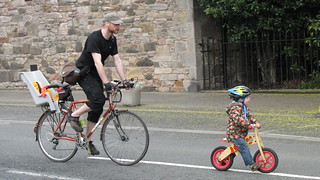@cb
The question is from a set about physical activities undertaken in the past 28 days and includes cycling for at least 30 minutes.
CityCyclingEdinburgh Forum » General Edinburgh
Where cyclists live
(53 posts)-
Posted 13 years ago #
-
" Nationally, it is five times more common in affluent areas than it is the most deprived."
Are people living in affluent areas five times more likely to have a job that those living in deprived areas? After all, you are not going to be commuting to work if you don't have a job.
Posted 13 years ago # -
Member
PM this userCustard "large shops and going on family days out" . Let me know if you want to borrow our trailer and try it out. Really very handy, even just for the shopping, and some bargains to be had on ebay/gumtree/NNS.
Cheers :)
As to how to spend the 5% transport capital budget? Well the word transport is a strong indication, it should be used to make using a bicycle as a means of transport save and convenient. This really means providing good infrastructure on primary routes, so that it is quick and easy to get to places that people want to go.
I was pondering this.
If the whole 5% was 'simply' spent on improving cycle lanes,parking etc for bikes
nothing on courses,promotion etc
would it create an increase of cyclists and as such create a higher presence of cycling in the city.
so first you get folks who maybe occassionaly cycled
others see it and give it a tryIt doesnt take much. after I started cycling to work with a C2W bike
5 other people got a C2W bike,and sporadically commutePosted 13 years ago # -
@min
No, they're not five times more likely to have a job - 45% of adults in the most deprived areas are in work compared with 57% of adults in the least deprived areas.Posted 13 years ago # -
@Kim
Sorry, I meant to come back to the substance of your comment rather than the data bit of it. You said about the capital spending, "it should be used to make using a bicycle as a means of transport safe and convenient. This really means providing good infrastructure on primary routes, so that it is quick and easy to get to places that people want to go."
I don't see how making cycling as a means of transport safe and convenient leads directly to 'providing good infrastructure on primary routes'. I'm sure that's what it would mean for some people - those people who are currently travelling within the green core - but for people outside that area it could just as easily mean something else. It could mean, for example, upgrading the paths on the canal to provide a high quality 'superhighway' from the outskirts to the centre.
My reason for creating the map in the first place was to ask whether it wouldn't be better in the long run and from a general societal point of view to invest in connecting the periphery by bike to increase the level of cycling rather than make the green core more comfortable. Of course, it would be disheartening for those who did the campaigning to see the money spent elsewhere.
Posted 13 years ago # -
Insto- It seemed a bit unlikely but I thought I would ask.
I am not sure. It is definitely true that the less affluent areas tend to be very highly motorised with big fast roads running through them. After all, rich people demand to live in quiet leafy streets without other car-owners driving past constantly. I am also pretty sure Morningsider is correct about status and cars but perhaps now that cycling is becoming more popular the status symbol might change? At the moment, a fair swathe of purple on that map actually has the North Edinburgh cycle network running through/near it which is by far the most superior cycling facility we have.
What sort of thing did you have in mind?
Posted 13 years ago # -
"Living in an area with poor quality housing, low employment rates and high crime levels impacts on the health and wellbeing of all those that live there and perpetuates both the generational and geographical experience of poor outcomes. The most acute levels of deprivation tend therefore to be highly localised, with a spatial clustering of poor outcomes. Evidence indicates that tackling these multiple problems in isolation addresses neither the experience of negative outcomes through people’s lives, nor their root causes."
http://drpetermatthews.blogspot.com/2012/02/return-of-place-in-scottish-public.html
Posted 13 years ago # -
"
TransportationNation (@TransportNation)
2/24/12 5:24 PM
"Biking has become the mode of choice for the educated high-tech worker"http://transportationnation.org/2012/02/23/for-the-tech-sector-bikes-are-the-new-cars
"Posted 13 years ago # -
Primary routes are primary route because they go where people want to go! The canal path is nice as a leisure route but as direct for most purposes (I have used it). I have seen people drive to Roseburn path to take a leisure ride. The other thing about the canal path is that is already at capacity. A lot of people aren't going to want to ride along a narrow crowed path next to (what they may feel is deep) water.
If we are going to get cycling to be rearguard as a serious form of transport, we are going to have to make it feel safe and convenient for the majority of the population. That means providing good infrastructure on primary routes.
There is a very real snobbishness about the idea of having separated infrastructure, really cyclist want to ride with the traffic. But most people don't want to be *real* cyclist. Having spent a lot of time looking at places where cycling has a modal share of more than 10% I have noticed that the common denominator is that there is good infrastructure on primary routes. Cycling is treated as a serious transport option. No one is told that they have to ride with the traffic, that they have to be assertive and claim their lane, or they have to dress in a special way in order to be safe.
IF we really want Edinburgh to reach its Charter of Brussels target of at least 15% for the share of cycling in the modal split of trips for the year 2020. We are going to have learn from places where cycling really works as a means of transport.
Posted 13 years ago # -
"The canal path is nice as a leisure route"
Yes.
AND as a primary route for people in Tollcross, Polwarth etc. wanting to go to Wester Hailes, Gyle etc.
(Bit like Lothian Road is a primary route for people living in Tollcross wanting to go to Princes Street.)
"A lot of people aren't going to want to ride along a narrow crowed path next to (what they may feel is deep) water."
True.
A lot of people wouldn't want to ride on Lothian Road.
"The other thing about the canal path is that is already at capacity."
Not really.
Some parts at some times of day, when it's sunny.
"There is a very real snobbishness about the idea of having separated infrastructure"
Is there?
There are people who underestimate how much lack of 'proper' infrastructure discourages 'ordinary' people from cycling.
There are people wary about being 'made' to use less than satisfactory 'designated' cycle infrastructure.
There are people who would rather not wait for 'perfect' infrastructure.
There are people who don't want lack of 'perfect' infrastructure to be used as an excuse.
"But most people don't want to be *real* cyclist"
True (including me).
"I have noticed that the common denominator is that there is good infrastructure on primary routes. Cycling is treated as a serious transport option."
Yes, but that is always the 'chicken and egg' issue. And how is 'driver attitude' etc. in such places? And how long did it take for it to change?
"No one is told that they have to ride with the traffic, that they have to be assertive and claim their lane, or they have to dress in a special way in order to be safe"
Perhaps, but that is advice by some people who are experiencing current conditions but are not saying 'and that's the way it is and always will be'.
Things are changing - more slowly than you, I and many others would like, but there is no perfect future that will come when "separated infrastructure" is perfectly in place.
Can't wait that long.
Posted 13 years ago # -
"Biking has become the mode of choice for the educated high-tech worker"
Maybe in the sunshine state, but probably not so much here. For example, our all-degree office has 16 occupants. Two alway arrive by bike (from Edinburgh and Glasgow). One more usually does (from Edinburgh). Why don't the others?
Easy.
Shoestring budgets for UK tech startups mean out-of-town locations (L'gow/Livi etc) in buildings with minimal facilities and no showers or bike racks any of that stuff. Google it ain't and nice offices where the Brewery was? Probably not really.
Posted 13 years ago # -
I am in Wester Hailes a fair bit for work. There are cars but for the density of population not that many.
The canal is quiet pretty much all the time, mostly Heriot Watt commuters. It starts to get busier once you cross the aqueduct at Slateford in the morning rush or on a Sunday jaunt, otherwise it is great if your house is close to it and where you want to go is close to it.
I would take a punt and say it is the most direct route into Edinburgh from beyond the bypass that stays on the same contour line (roughly speaking).
Wester Hailes is another country. The cinema is generally quiet, except on aSunday morning when it is used as a church. The squash courts are available, the books are in the library, LIDLs is quiet, the train stops but no one gets on or off. Come Friday night the streets are hoaching according to the community bobby.
Posted 13 years ago # -
How is the degree of reality of a cyclist determined by their proximity to traffic?
Leisure riding is of immense value in practising the physical process of cycling, the better to be able to undertake it in non-leisure situations, should the need arise.Posted 13 years ago # -
"Leisure riding is of immense value in practising the physical process of cycling, the better to be able to undertake it in non-leisure situations, should the need arise"
Yep, something that people who complain about Sustrans (and off-road paths generally) don't understand.
Posted 13 years ago # -
Chdot a contour canal closely follows the contour line. this is close enough for me but in a futile attempt to avoid being pulled up I used the phrase roughly speaking.
Hoaching is busy, as indeed is hooching. Hooching is too close to yee-hooching which is a noise you can get away with making at a ceilidh ad infinitum without being pulled up, although you get funny looks. Danced an Orcadian Strip the Willow where I yee-hooched everyone I birled recently.
Posted 13 years ago # -
"Chdot a contour canal closely follows the contour line. this is close enough for me but in a futile attempt to avoid being pulled up I used the phrase roughly speaking."
I think you were actually more correct!
A true contour canal wouldn't have aqueducts!
Your basic point that the Union Canal is probably the optimum way to get to central Edinburgh from Ratho, HW, WH is also very true.
There are people who will have a problem with the aqueduct, but almost certainly more who would not like the A70, A71, A8 etc.
Posted 13 years ago # -
Without aqueducts would create big meanders. If scared of heights they are tricky. Getting off and pushing as instructed on the sign makes for generally safe crossing. the whole feat of engineering is a marvel. Given they have been around for a very long time it is great that they are still useful. Stirring tales from the north of England of local groups taking ten years to dig out the infill and make them navigable again.
Posted 13 years ago # -
"Given they have been around for a very long time"
Lots of possibilities for anniversaries.
2020 (when Edinburgh is supposed to have 15% of journeys by bike) will be 200 years since the canal was half built...
Posted 13 years ago # -
The grand canal in china has been around since 609 AD (wiki). Still in use and still the longest in the world (1000 plus miles). Also only took 4 years to build tho like systems it was partly connecting up existing canals. wow
Posted 13 years ago # -
One of the questions about the areas with high levels of cycling is how much higher it could be. Already it is likely to be between 13% and 28% in the areas that I shaded green. If the 5% is spent there, what could it become?
Would it be a cost-effective use of the money to increase cycling in those areas by, I don't know, 5%? Might it be better to spend the money in areas of very low participation and increase the rate by 10% or 15% and get all the associated transport and health benefits that have already been gained in the green areas by spending next to nothing?
Posted 13 years ago # -
I think the answers to your questions are - "nobody knows".
There have been lots of surveys about why people don't cycle.
Answers include - danger (perceived or real), hills, weather, fitness etc.
There are disagreements about what constitutes 'better infrastructure'. Some people don't think that ASLs are a good idea.
Some people seem to think that off road routes are not a good idea.
To take an extreme case - if there were no motor vehicles there wouldn't be much need for infrastructure improvements.
Similarly if all drivers were careful and considerate more people would be happy about cycling.
There are lots of things that happen to be in central Edinburgh that need improving - North Meadow Walk and the Gifford Park - Rankeillor Street link for instance.
There are plenty of places in more peripheral parts of Edinburgh where simple things like tarmaccing desire lines/informal paths would make a big difference - for pedestrians as well as cyclists.
If the amount of money that's been spent on the tram had been put into walking and cycling the city would have been transformed.
But as this and many other threads have discussed it's not just about infrastructure.
There have been all sorts of initiatives and programmes for promotion, education, training etc.
Some work better than others. Some might even be assessed to be 'cost effective', but realistically there are far too many variables to get any sort of firm conclusions on any (potential) 'magic bullets'.
I have met many children who don't cycle because their bike "has got a puncture". The chances are it hasn't but there's no pump in the house or the tools to take the wheel/tyre off or an adult who would know how to do it.
There are no parents who cycle - so no positive role models (in this context) - or, obviously, adults that seem likely to cycle - there won't even be a 'bike in the garage gathering dust'.
There are very good reasons for spending money in the purple areas to encourage cycling - social inclusion, health etc. etc. - there would even be 'transport' spin-offs.
But it's not easy and far from straightforward. Until councils and governments are prepared to genuinely embrace joined-up-thinking and work across departmental silos and budgets and worry less about disciplines and boundaries and hierarchies and targets and conclusive evidence etc. etc. etc. it ain't gonna happen.
Posted 13 years ago # -
As just posted on another thread!
"
Got my ex cycling by dint of fixing up a beater and introducing them to the off road paths of Edinburgh (the path along the Esk always delights new riders) and they used it for commuting after that, however since we broke up I think its declined and stopped now they don't have anyone to do their servicing for them.http://citycyclingedinburgh.info/bbpress/topic.php?id=5446#post-58283
"
As I was more or less saying - needs more people cycling - preferable ones who are confident about showing others how/where to cycle + the ability to keep bikes on the road (or the money to pay someone else).
It's happening slowly.
Free bikes can help too.
Posted 13 years ago #
Reply
You must log in to post.

 posts
posts
